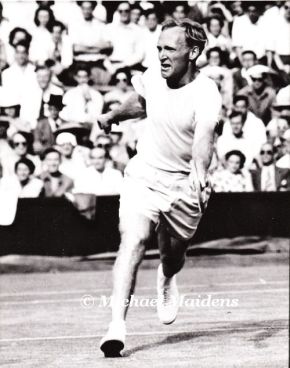This seems to be a question often raised around tables, at least when the veterans are sipping on a cup of tea (nee Bundy, Jack Daniels, Beer).
In an article, in USA Tennis Magazine March 1997, written by Tennis Authority Alan Trengove, Mark Phillippousis was given the task of testing out woodies versus a standard graphite (his own) and a superlong. The reason the article was written was because the ITF had just banned the SuperLong’s being marketed by both Dunlop and Gamma. This meant that all professional racquets had to be under 29″ in length. I recently saw a Gamma 32″ and it really is a massive racquet with a 137″ head size. See the pic below compared to a standard woodie. To meet the new rules they just chopped the length back to 28″.

Anyway back to the test. All the racquets were strung by Mark’s personal stringer using the strings and tensions he was used to and grips were adjusted as well. They were the Dunlop Superlong 29 1/2″, his standard 27″ Dunlop and the recently voted number one racquet of significance over the past 50 years, the wonderful Dunlop Maxply Fort specially flown over from the UK.
The test was conducted at the Melbourne Park, home of the Australian Open.
The results were very interesting. Wood Ave Speed 122mph, Top Speed 124mph and accuracy 60%. Standard length 124mph, 127mph, 52% and Superlong 126mph, 127mph, 80%.
On speed it is surprising that only 3 mph separates the woodie from the two hi tech racquets and the woodie even gave Mark some more accuracy over his standard racquet. Maybe Bjorn should have persisted with his woodie in his infamous come back!!! Then maybe Mark should have tried a Woodie more often!!
In a separate, similar test in the USA, four players confirmed these results but found the woodies accuracy levels very low. I guess this does highlight the impact of frame strength and sweet spot size. However, given that these 4 hadn’t played with a Woodie at all or for many years, it also highlights how stroke techniques have changed with racquets. The importance of hitting with woodies using a more flat stroke and good follow through is certainly not in vogue today as follow throughs are moving across the body or at seems in full circle watching the almost table tennis style forehands seen today.
Were the players of old serving at Speeds like Mark? There may have been some big guns back then, but the rules for foot faulting didn’t allow both feet to be off the ground and over the line, so the level of forward momentum couldn’t have been the same.
The other factor was championship play was continuous so there were no sit down breaks between end changes because there were no chairs and no tie breaks which meant a match could easily go 3-4 hours. The wise players of the day relied more on accurate first serves with more twist than pace as way of conserving energy.
The conclusion of the test was that while extra longs seem to assist with accuracy, the additional size, weight and therefore swing speed didn’t create the massive increase in serve speed the ITF were worried about preventing. It is also proves that you really can generate some service speed using an old woodie afterall and suprisingly not that much slower than today’s technologically advanced racquets.

You must log in to post a comment.